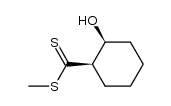(1R,2S)-2-Hydroxy-Cyclohexanecarboxylic Acid Ethyl Ester
Modify Date: 2024-01-03 00:11:23

(1R,2S)-2-Hydroxy-Cyclohexanecarboxylic Acid Ethyl Ester structure
|
Common Name | (1R,2S)-2-Hydroxy-Cyclohexanecarboxylic Acid Ethyl Ester | ||
|---|---|---|---|---|
| CAS Number | 61586-78-5 | Molecular Weight | 172.22200 | |
| Density | 1.093 g/cm3 | Boiling Point | 251.4ºC at 760 mmHg | |
| Molecular Formula | C9H16O3 | Melting Point | N/A | |
| MSDS | N/A | Flash Point | 100.2ºC | |
| Name | ethyl (1r,2s)-cis-2-hydroxycyclohexanecarboxylate |
|---|---|
| Synonym | More Synonyms |
| Density | 1.093 g/cm3 |
|---|---|
| Boiling Point | 251.4ºC at 760 mmHg |
| Molecular Formula | C9H16O3 |
| Molecular Weight | 172.22200 |
| Flash Point | 100.2ºC |
| Exact Mass | 172.11000 |
| PSA | 46.53000 |
| LogP | 1.10060 |
| Index of Refraction | n20/D 1.463 |
Synonym: Section 2 - COMPOSITION, INFORMATION ON INGREDIENTS
Risk Phrases: None Listed. Section 3 - HAZARDS IDENTIFICATION EMERGENCY OVERVIEW
Not available. Potential Health Effects Eye: May cause eye irritation. Skin: May cause skin irritation. May be harmful if absorbed through the skin. Ingestion: May cause irritation of the digestive tract. May be harmful if swallowed. Inhalation: May cause respiratory tract irritation. May be harmful if inhaled. Chronic: Not available. Section 4 - FIRST AID MEASURES Eyes: Flush eyes with plenty of water for at least 15 minutes, occasionally lifting the upper and lower eyelids. Get medical aid. Skin: Get medical aid. Flush skin with plenty of water for at least 15 minutes while removing contaminated clothing and shoes. Ingestion: Get medical aid. Wash mouth out with water. Inhalation: Remove from exposure and move to fresh air immediately. If not breathing, give artificial respiration. If breathing is difficult, give oxygen. Get medical aid. Notes to Physician: Section 5 - FIRE FIGHTING MEASURES General Information: As in any fire, wear a self-contained breathing apparatus in pressure-demand, MSHA/NIOSH (approved or equivalent), and full protective gear. Extinguishing Media: Use water spray, dry chemical, carbon dioxide, or chemical foam. Section 6 - ACCIDENTAL RELEASE MEASURES General Information: Use proper personal protective equipment as indicated in Section 8. Spills/Leaks: Absorb spill with inert material (e.g. vermiculite, sand or earth), then place in suitable container. Section 7 - HANDLING and STORAGE Handling: Avoid breathing dust, vapor, mist, or gas. Avoid contact with skin and eyes. Storage: Store in a cool, dry place. Store in a tightly closed container. Section 8 - EXPOSURE CONTROLS, PERSONAL PROTECTION Engineering Controls: Use adequate ventilation to keep airborne concentrations low. Exposure Limits CAS# 61586-78-5: Personal Protective Equipment Eyes: Not available. Skin: Wear appropriate protective gloves to prevent skin exposure. Clothing: Wear appropriate protective clothing to prevent skin exposure. Respirators: Follow the OSHA respirator regulations found in 29 CFR 1910.134 or European Standard EN 149. Use a NIOSH/MSHA or European Standard EN 149 approved respirator if exposure limits are exceeded or if irritation or other symptoms are experienced. Section 9 - PHYSICAL AND CHEMICAL PROPERTIES Physical State: Liquid Color: Not available. Odor: Not available. pH: Not available. Vapor Pressure: Not available. Viscosity: Not available. Boiling Point: Not available. Freezing/Melting Point: Not available. Autoignition Temperature: Not available. Flash Point: Not available. Explosion Limits, lower: Not available. Explosion Limits, upper: Not available. Decomposition Temperature: Solubility in water: Specific Gravity/Density: Molecular Formula: C6H10(OH)COOCH2CH3 Molecular Weight: 172.1102 Section 10 - STABILITY AND REACTIVITY Chemical Stability: Not available. Conditions to Avoid: Incompatible materials. Incompatibilities with Other Materials: Strong oxidizing agents. Hazardous Decomposition Products: Carbon monoxide, carbon dioxide. Hazardous Polymerization: Has not been reported Section 11 - TOXICOLOGICAL INFORMATION RTECS#: CAS# 61586-78-5 unlisted. LD50/LC50: Not available. Carcinogenicity: ETHYL (1R,2S)-2-HYDROXYCYCLOHEXANECARBOXYLATE - Not listed by ACGIH, IARC, or NTP. Section 12 - ECOLOGICAL INFORMATION Section 13 - DISPOSAL CONSIDERATIONS Dispose of in a manner consistent with federal, state, and local regulations. Section 14 - TRANSPORT INFORMATION IATA Not regulated as a hazardous material. IMO Not regulated as a hazardous material. RID/ADR Shipping Name: Not regulated. Hazard Class: UN Number: Packing group: Section 15 - REGULATORY INFORMATION European/International Regulations European Labeling in Accordance with EC Directives Hazard Symbols: Not available. Risk Phrases: Safety Phrases: S 24/25 Avoid contact with skin and eyes. WGK (Water Danger/Protection) CAS# 61586-78-5: No information available. Canada None of the chemicals in this product are listed on the DSL/NDSL list. CAS# 61586-78-5 is not listed on Canada's Ingredient Disclosure List. US FEDERAL TSCA CAS# 61586-78-5 is not listed on the TSCA inventory. It is for research and development use only. SECTION 16 - ADDITIONAL INFORMATION N/A |
| HS Code | 2918199090 |
|---|
| HS Code | 2918199090 |
|---|---|
| Summary | 2918199090 other carboxylic acids with alcohol function but without other oxygen function, their anhydrides, halides, peroxides, peroxyacids and their derivatives。Supervision conditions:None。VAT:17.0%。Tax rebate rate:9.0%。MFN tariff:6.5%。General tariff:30.0% |
| Ethyl-trans-2-cyanocyclopropancarboxylat |
| trans-1-Cyano-2-ethoxycarbonyl-cyclopropan |
| trans-1-Cyan-2-ethoxycarbonyl-cyclopropan |
| (1R,2S)-2-Hydroxy-Cyclohexanecarboxylic Acid Ethyl Ester |
| ethyl (1R,2S)-2-hydroxycyclohexanecarboxylate |
 CAS#:1655-07-8
CAS#:1655-07-8 CAS#:107290-93-7
CAS#:107290-93-7 CAS#:108-05-4
CAS#:108-05-4 CAS#:108-94-1
CAS#:108-94-1 CAS#:83392-41-0
CAS#:83392-41-0 CAS#:28637-53-8
CAS#:28637-53-8